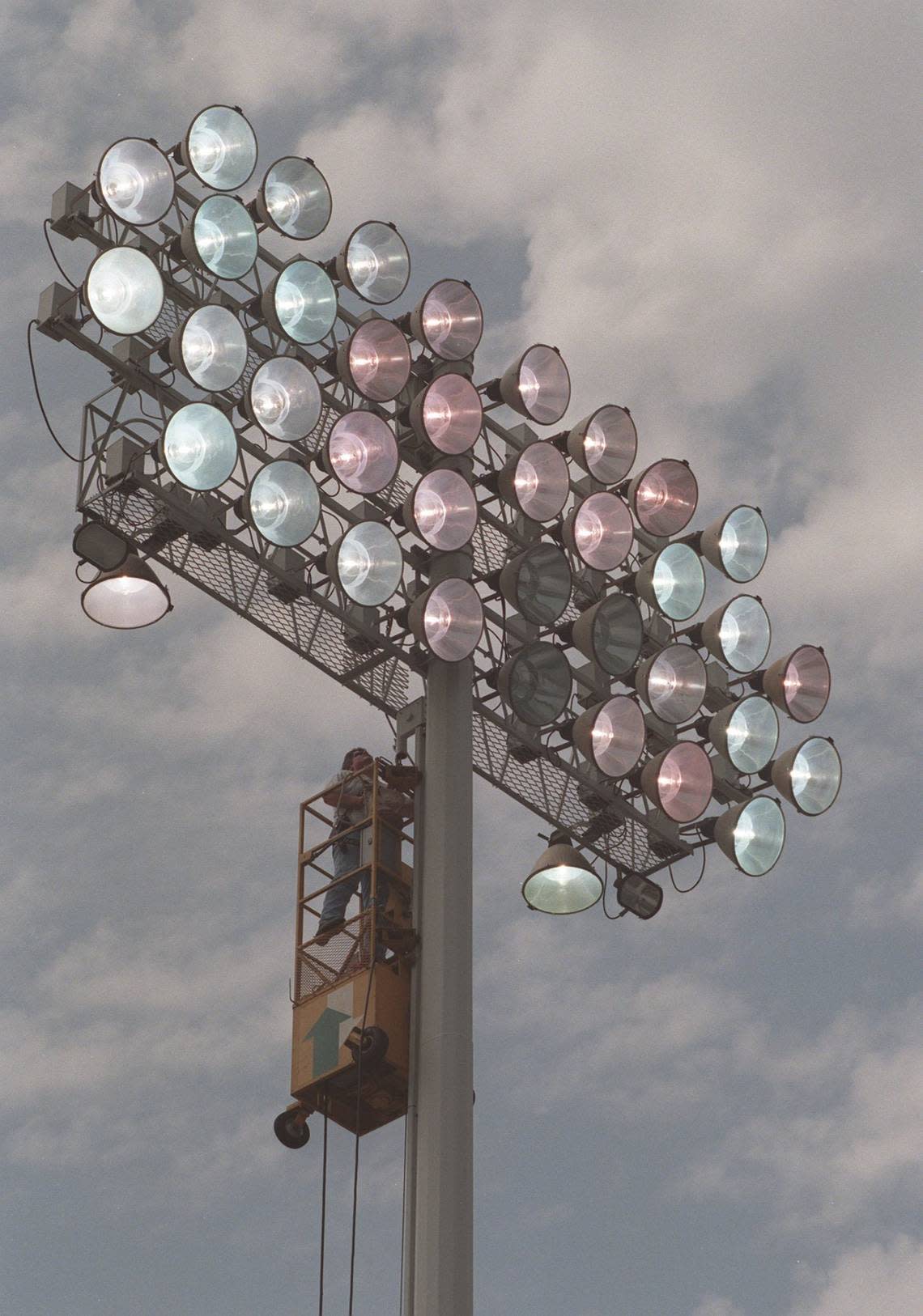The night the lights came on (literally) for Kentucky Wildcats football
Though 93 years have elapsed, the opening game of the 1929 Kentucky football season lives on in Wildcats sports lore for two important reasons.
In a 40-0 thrashing of Maryville College, iconic UK running back John “Shipwreck” Kelly made his Wildcats varsity debut. A product of Springfield in Washington County, Kelly would go on to play in the NFL for the New York Giants and the Brooklyn Dodgers. He would also inhabit the society pages of New York City’s newspapers due to his 1941 marriage to socialite and heiress Brenda Frazier. Against Maryville, Kelly delivered a preview of the star he would become at Kentucky by running for four touchdowns.
Played on Oct. 5 at Stoll Field, the 1929 season opener was also the first night game in which a University of Kentucky football team played.
UK announced in May of 1929 that the Wildcats’ opening football game the following fall would be played at night. The primary reasons sited by the university for adding lights were to give players cooler weather in which to play early in seasons and to boost attendance.
A crowd between 7,500 and 8,000 came out to experience what Lexington Leader sportswriter Neville Dunn described as “Stoll Field ablaze with light for this strange nocturnal debut of the Big Blue.”
According to current UK sports publicists, Kentucky was the first of the schools now in the Southeastern Conference to play a night football game.
Yet the Wildcats’ first game under the moon and stars was the third college football game played at night in Lexington in 1929.
Transy makes state history
Playing under a blaring sun during the early parts of college football seasons was not the only problem that arose from the lack of stadium lights. For the college football player of the 1920s, darkness was not a friend.
In the years leading up to 1929, the absence of light seemed to have been a particular problem for the Transylvania football program. According to the Sept. 11, 1929, Lexington Herald, Transy and Centre were locked in a scoreless tie in the game to decide the 1926 Kentucky college state championship — only to see the contest end prematurely due to the onset of nightfall. Two years later, the Pioneers played the entire fourth quarter against Kentucky Wesleyan in darkness.
Before Coach James A. Elam’s Pioneers could face similar hardship in 1929 at Thomas Field, Transylvania installed what the Lexington Herald’s Vernon D. Rooks called “16 incandescent lights that will turn night into day.”
For their 1929 season opener, the Pioneers faced Bethel College on Sept. 14. It became the first college football game played under lights in Kentucky. To help players see the ball at night, the game was played with a football that had been painted white.
In the ensuing day’s Lexington Leader, the multi-deck headlines told the story: “Pioneers Crush Bethel Eleven 51-0. Crowd of 3,000 Persons Attends the Season Opener. Sixteen Huge Floodlights Illuminate the Playing Field as Bright as Day.”
The following Saturday, the Pioneers came back and won the second night game in Kentucky history by pulverizing Cedarville 71-6.
Cats prowl at night
Transylvania playing twice at night in the previous weeks seemed to take some of the novelty off of UK’s debut under its own new lights at Stoll Field.
“This engagement will mark the inauguration of night football at the University of Kentucky (but) will be the third (such game) played in Lexington this season,” the Lexington Herald’s Frank K. Hoover wrote in his game advance for UK-Maryville.
Nevertheless, the crowd that came to Stoll Field for Kentucky-Maryville under the stars was thought to be the largest to attend a season-opening football game at UK at that time.

In the aftermath of UK’s pasting of Maryville, the verdict on night football from Lexington sportswriters covering the game was mixed.
The Herald’s Hoover — who must not have understood how much stress tight, nighttime deadlines would create for future generations of his profession — gave night football a full-throat endorsement. “It was the unanimous opinion that the Wildcats should play every game on their schedule under the mellow rays of flood lights,” Hoover wrote.
Conversely, the Leader’s Dunn said that a game played at night made it hard for sportswriters to correctly recognize the players from the press box. “Newspapermen during the game were at a complete loss to identify some of the players, especially the Maryville team,” Dunn wrote.
More change comes to UK
Night college football came to Kentucky before either Major League Baseball or the National Football League incorporated playing under the lights.
The first NFL game played at night was on Nov. 6, 1929, when the Chicago Cardinals defeated the Providence Steam Roller 16-0 at Rhode Island’s Kinsley Park Stadium.
With considerably more fanfare, MLB’s initial night game occurred at Cincinnati on May 24, 1935. Before the game, President Franklin Delano Roosevelt pressed a telegraph key in the White House that sent an electric pulse 500 miles over copper wires to a signal lamp near first base at Crosley Field. When the lamp went on, Reds President Larry MacPhail knew to flip the switch to turn on the 632 floodlights the Reds had installed above the ballpark.
Interestingly, the winning pitcher in the Reds’ 2-1 win over the Phillips in the first MLB night game was Paul Derringer who, like “Shipwreck” Kelly, was from Springfield.
Before the second UK game of the 1929 season against Washington & Lee, the Lexington Herald reported that “loud speakers have been installed on Stoll Field for the game and a play-by-play report will be announced through an amplifier.”
For Kentucky football fans, the times, they were a-changin’.
